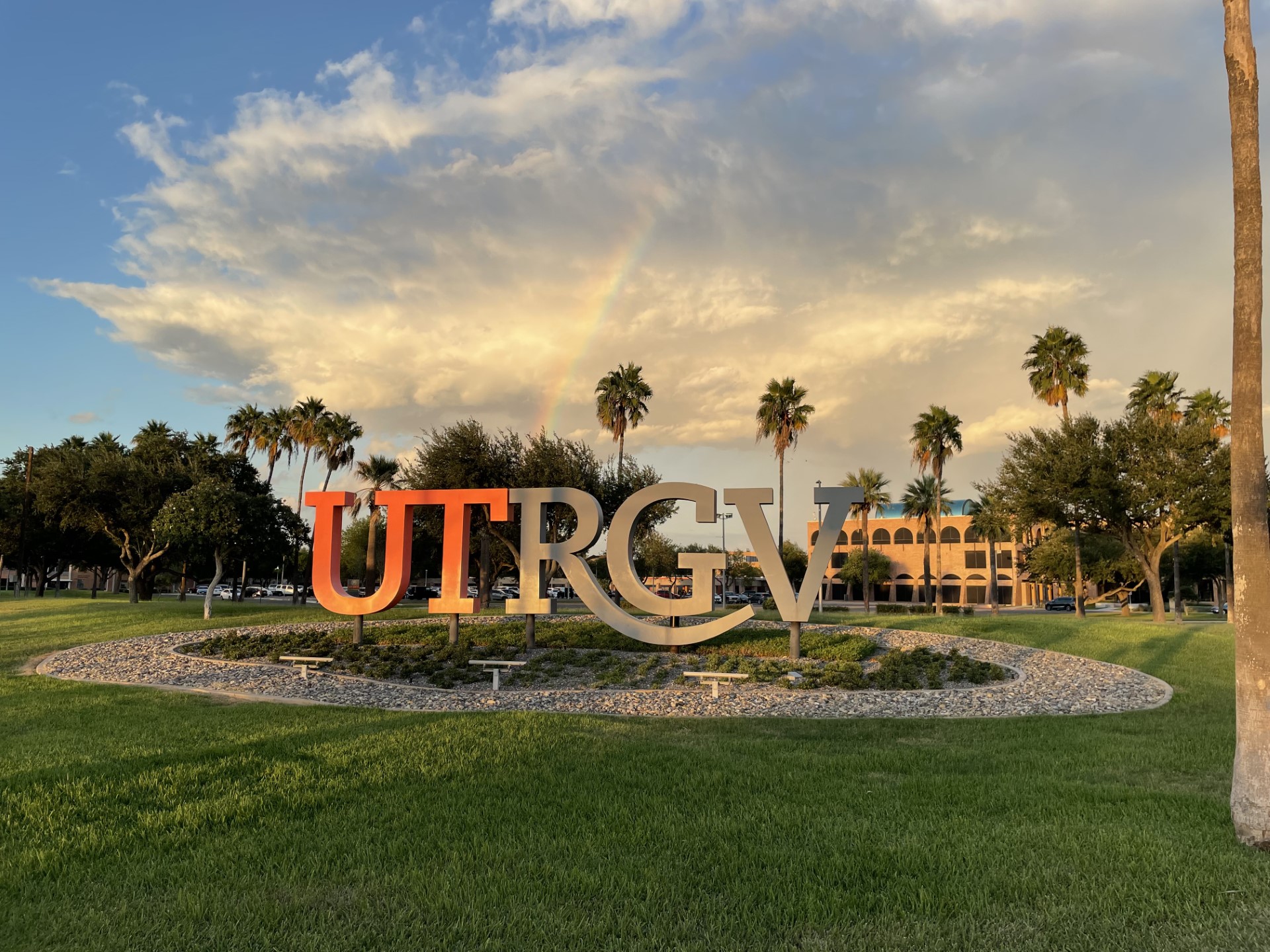About Me
Academic:
I'm an Assistant Professor in the School of Mathematical and Statistical Sciences at The University of Texas Rio Grande Valley. Before this, I was an Assistant Adjunct Professor for the Program in Computing at the University of California, Los Angeles, where I also held an NSERC Postdoctoral Fellowship. I completed my doctor of philosophy at the University of British Columbia in Vancouver, BC, Canada.
I've always enjoyed applications of math, but I find theory can be useful and beautiful, too. I've worked on a variety of applied projects, with a few currently underway - see the research portion of this page for details of the various projects. To be very brief, the problems I'm currently working on are:
- modelling the influence of brain structure on the progression of neurodgenerative diseases — NSF Funded;
- studying air turbulence data to build live maps;
- looking into patterns in client-level mental health records across the nation;
- developing predictive models for homeless populations and quantifying emergent properties within the state of homelessness; and
- modelling origin of life without DNA.
These projects combine many fascinating mathematical fields including ordinary and partial differential equations, data science, asymptotic analysis (analytic approximation schemes), and numerical analysis (studying how the problems can be coded and accurately solved with a computer). At the end of the day, though, being able to say something about the real world is what motivates me most (although the math is super cool!!!).
Personal:
I grew up in Winnipeg, Manitoba—the mosquito capital of Canada... also famous for the fantastically cold winters, which I am pleasantly reminded of each year when I go back to see family and friends over the break.
I completed my university education in the beautiful city of Vancouver, British Columbia (at UBC), with tons of beautiful parks and hiking trails in close proximity. I'll miss Vancouver's stellar public transit system, close proximity to nature, countless delicious restaurants, and amazing simultaneous views of the mountains and ocean!
I did live in Los Angeles for a number of years doing my postdoc at UCLA. While I can't say that LA was my favourite city, I did enjoy the weather. The food was also pretty good, but nothing was accessible without an extensive commute.
I really like the Rio Grande Valley so far: the people are friendly and the cost of living is very reasonable. The weather kills me, though. Being Canadian, I don't deal with heat very well.
Some other interests include:
-
Ultimate Frisbee! Don't let the assisant professor title fool you. It's mostly a front to be able to organize weekly games of Ultimate! I started playing with friends back at UCLA and have brought along the tradition. If you're reading this and like Frisbee, hit me up (we usually play Fridays after work when the sun is less intense)!
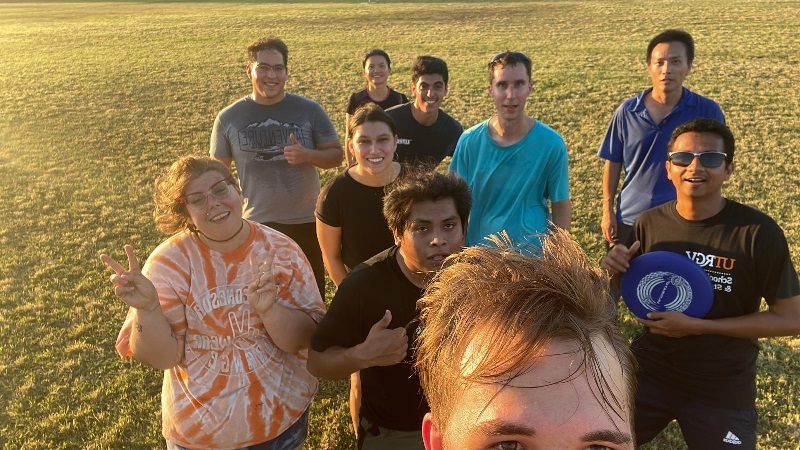
- Running (it doesn't involve hand-eye coordination so I'm drawn to it).
- Classical music (many pieces by Beethoven, Vivaldi, Mozart, Bach, Handel, or even very ancient, traditional music).
- Cats... they are such amazing creatures.
- Healthy eating, especially plant-based food.
- Meditation: I am very interested in ancient traditions and their practices.
I'm also a fan of Piled Higher and Deeper comics (reasonably accurate depictions of what it's like to be a grad student—I remember those days...).
Research
Research Experience and Interests
Projects I have worked on / am current work on are below.
Current Work
- Air Turbulence: though the 2022 Montreal IPSW, we began a proof of concept for a method to impute turbulence for short intervals in the future based on prior readings local in space and time. We are now working to optimize the method and improve our knowledge of the physics.
- Homelessness: Los Angeles, along with many major cities, has a huge homeless problem. Right now there are over 50,000 homeless people in Los Angeles, and the problem is very complicated. There is little understanding as to the mechanisms that yield such high rates of homelessness and how individual characteristic traits influence the outcome of homeless individuals. Read More.
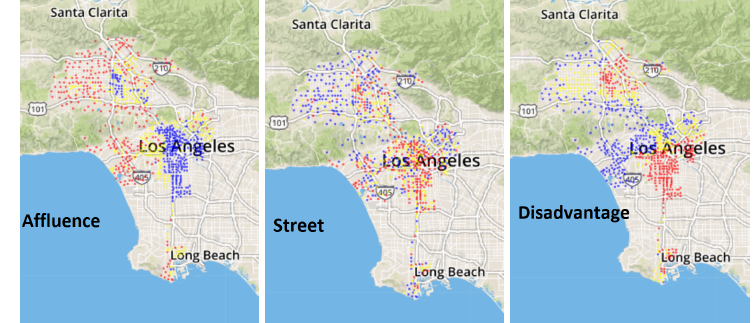
Past Work
-
Alzheimer's Disease: Alzheimer's Disease is a tragic disease resulting in the gradual loss of memory and cognitive function and currently the most common dementing illness in the world with incidence (one's risk) doubling every 5 years! Read More.
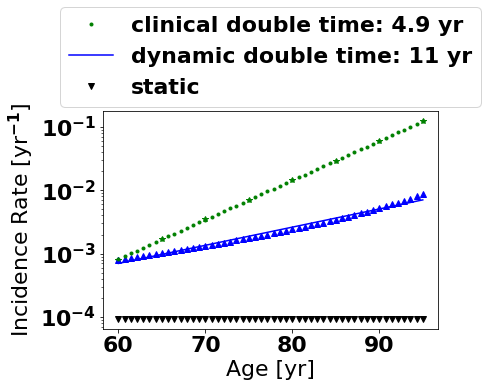
- COVID-19: the global pandemic of COVID-19 has brought many challenges in how we deal with it as a society to keep everyone safe, to predict future outcomes, and to understand disease mechanisms. I'm working wrapping up a few projects related to this disease— and maybe more will start up.
-
Fluid Flows: When particles are suspended in a highly viscous oil and allowed to flow down an incline, there are two qualitatively distinct regimes: at low particle concentration / inclination angle, the fluid and particles separate; at high particle concentration / inclination angle, the particles stay mixed in the fluid and become more concentrated at the leading front. In some experiments we ran, we noticed the particles and fluid stayed well mixed and didn't bifurcate over the length of the incline. Read More.
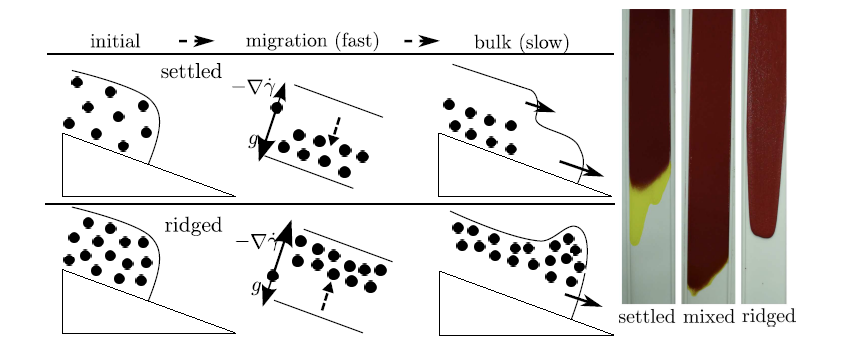
-
Nuclear Fusion: Magnetized target fusion is a relatively new idea for producing conditions for hydrogen fusion on earth. The essence of the idea is to confine a plasma in a magnetic field and compress it by an intense pressure-focused pulse so that it yields a high enough particle density and pressure for fusion to take place, releasing energy. Read More.
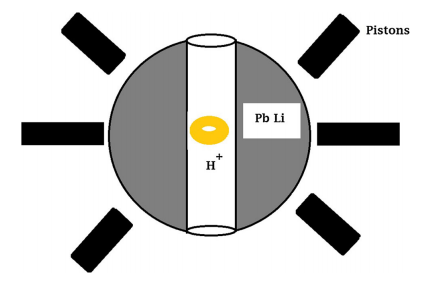
-
Spatial Risk Segmentation: Through an industrial problem solving workshop in Montréal, a team of us worked to develop and adapt interpolation methods to predict the risk a client will need to make a claim on property insurance using geographic features and client-specific information. We used Geographically Weighted Regression, Poisson Kriging, and Fused Lasso to estimate how risk varies over space.
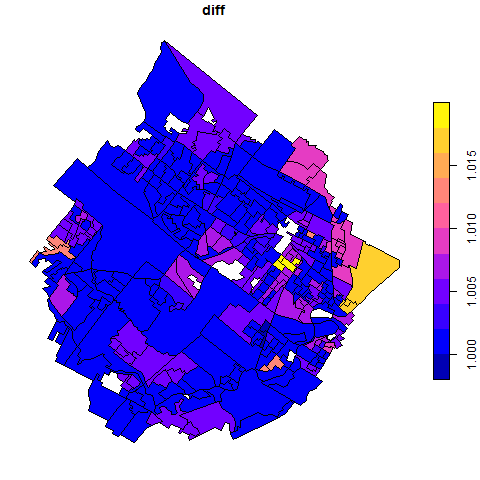
- Twitter Data: Twitter is a popular social network where users "tweet" short stories, comments, or ideas. The tweets themselves have a well-defined time, but also may include geotagging information such as the location the tweet was made. The amount of things one can do with this data is almost unlimited. We have focused upon dynamically clustering the tweets into topics and using the topics and information within the text of a tweet to infer a user's location information. We also found it is possible to predict the time/location of a "current event" by studying the frequency of tweets over space and time along with their corresponding topics.
- Osteogenesis Imperfecta VI: OI type 6 is a severe form of brittle bone disease where patients have bones that are both very soft (due to delayed mineralization) and very brittle (due to over mineralization). Researchers of the disease suspect an abnormally low concentration of a protein known as PEDF is responsible for the disease. Through an industrial workshop in Montréal, a group of us began to study the process of bone mineralization and the potential role of PEDF with mathematical models. Our work is very preliminary, but our current model qualitatively predicts the delayed bone development of OI type 6 patients if these patients have a decreased concentration threshold of calcification-inhibiting enzymes necessary for bone development. Here are slides from our oral report.
-
Superconductors: a superconductor, when in the Meissner state, expels magnetic fields from its interior. Very near its surface, there is an exponential decay in field strength that is predicted by the London equation, a special limit of the Ginzburg-Landau equations, provided the surface is flat. In the superconductivity literature, the assumption of a flat interface was taken for granted, but due to experimental measurements of a non-exponential decay in field strength near the surface of a superconductor, experimentalists asked the question of whether small-amplitude perturbations could have an effect on the field profile. Read More.
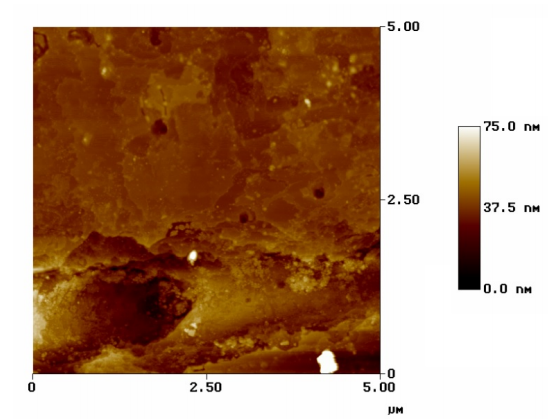
- Electrodialysis: Some modern plans for water filtration systems that purify salt water and those that can reduce the waste water of fracking use electrodialysis as a means to pass ions through selectively permeable membranes with the help of an electric potential gradient. I was involved in simulating the system under various settings, employing a combination of asymptotics and numerics. A paper that combines the theoretical work with experiment is here.
- Mass Spectrometry: A mass spectrometer separates atoms and molecules based on their mass. This has applications in detecting heavy metal or radioactive contaminants in air or water supplies. At a recent problem solving workshop, a group of us worked in collaboration with PerkinElmer on creating a new method of mass spectrometry that allows for continuous measurements of concentrations, without the costly use of magnetic fields. We found that it may be possible to create an electric field configuration that causes periodic oscillations dependent upon mass, which would allow for different chemical species to be separated spatially or detected with Fourier analysis. Our article on the problem is found here.
- Gas Diffusion in Fuel Cells: Fuel cells are costly to build, and developing accurate techniques to simulate their performance beforehand is essential in minimizing production costs. Unfortunately, there are many complex processes that take place within a fuel cell, one of the most important processes is gas diffusion. Those in industry who work with numerical simulations are often puzzled as to what formulation to adopt for gas diffusion: Fick (a simple gradient flow often formulated with a single Fick diffusion coefficient) or Maxwell-Stefan (a complex flow rate that depends upon the concentration gradients of all other species and experimentally determined binary diffusivities). The research I have been involved with on this topic was in studying the two formulations in a simple one-dimensional model of a PEMFC gas diffusion layer. Through nondimenzionalization, and a two-term formal asymptotic expansion, the two models provide nearly identical predictions. Furthermore, Fick diffusion is really a special limit of Maxwell-Stefan diffusion and in many industrial applications, the simpler Fick formulation can be used with reasonable precision. A paper explaining these results has been submitted to Heat and Mass Transfer.
- Malaria Management: Recently, a fungus has been discovered that could help reduce malaria-prevalence in endemic regions. The fungus infects mosquitoes, but instead of killing them like a pesticide, it kills the malaria that they carry and could transmit to humans. One biological question that arises is, if this fungus is used, should it be engineered to also kill mosquitoes? Read More.
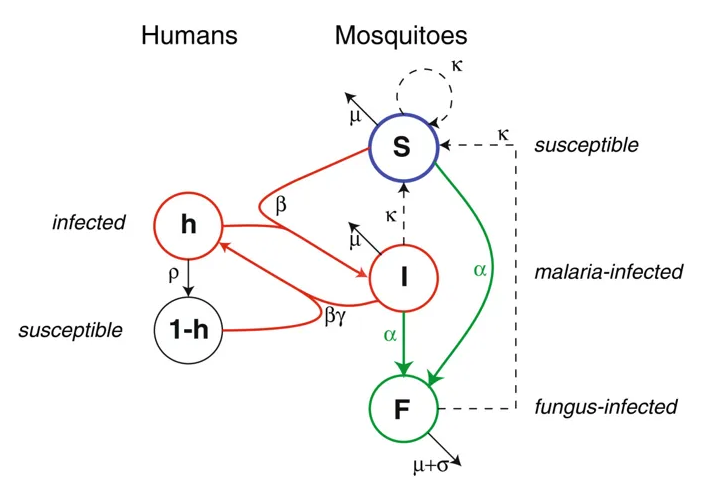
- Homicide: within homicide cases, there are many levels of detail that are poorly understood scientifically, including temporal patterns of homicide, how they relate to background levels of violence, whether a given case is likely to be closed, etc. Over the 2019 summer, I worked with a team to study these details of homicides and hopefully uncover meaningful insights.
- Gang Reduction and Youth Development (GRYD): The GRYD program schedules after-school programs and other supportive interventions for youths who are deemed at risk for joining gangs. We were provided with surveys the participants take, roughly every 6 months, with the surveys asking questions that attempt to measure the participant's attitudes and inclinations towards risky behaviours such as violence or lack of family contact. By modelling the responses as a dynamical system and using Dynamic Mode Decomposition (DMD), we have been able to analyze modes of growth and periodicity within the responses. DMD has also given us a means of predicting future risk-levels with comparable performance to a shallow neural network.
Research Group and Teams
Over the years I have worked with groups of students on research projects. The students have done amazing work and these collaborative projects have been among the most enjoyable experiences I've had in academia.
Through NSF Funding, I am currently recruiting one PhD student (beginning Summer 2024), one-two undergraduate students (beginning Autumn 2023), and a postdoc (beginning Autumn 2024) to join my group.
My current research group consists of
- Omar Sharif (PhD student)
- Myrine Barreiro-Arevalo (PhD student), co-mentored with Eloi Camprubi Casas in Astriobiochemistry
- Carlos Montes (MSc student)
- Joel Williams (Undergraduate)
Here are a collection of photos of various research groups and teams I have worked with over the years: so many great memories!
-
My research group over the 2023-2024 academic year. 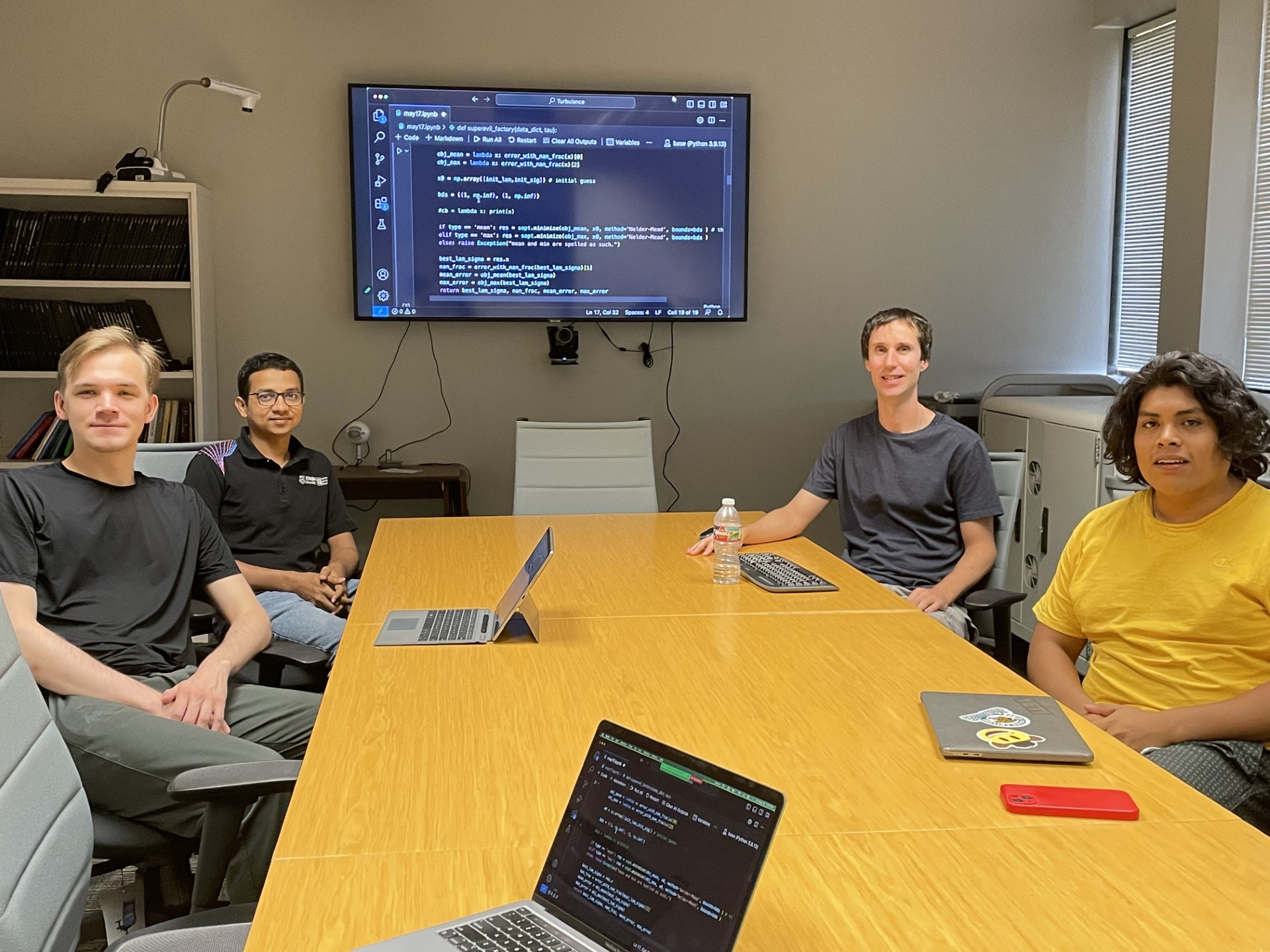
Joel Williams, Omar Sharif, myself, and Carlos Montes. Over the 2023 summer, I was a mentor for the UTRGV High Scholar Program. I mentored Aayush in a data-driven exploration of client-level mental health records across the US. 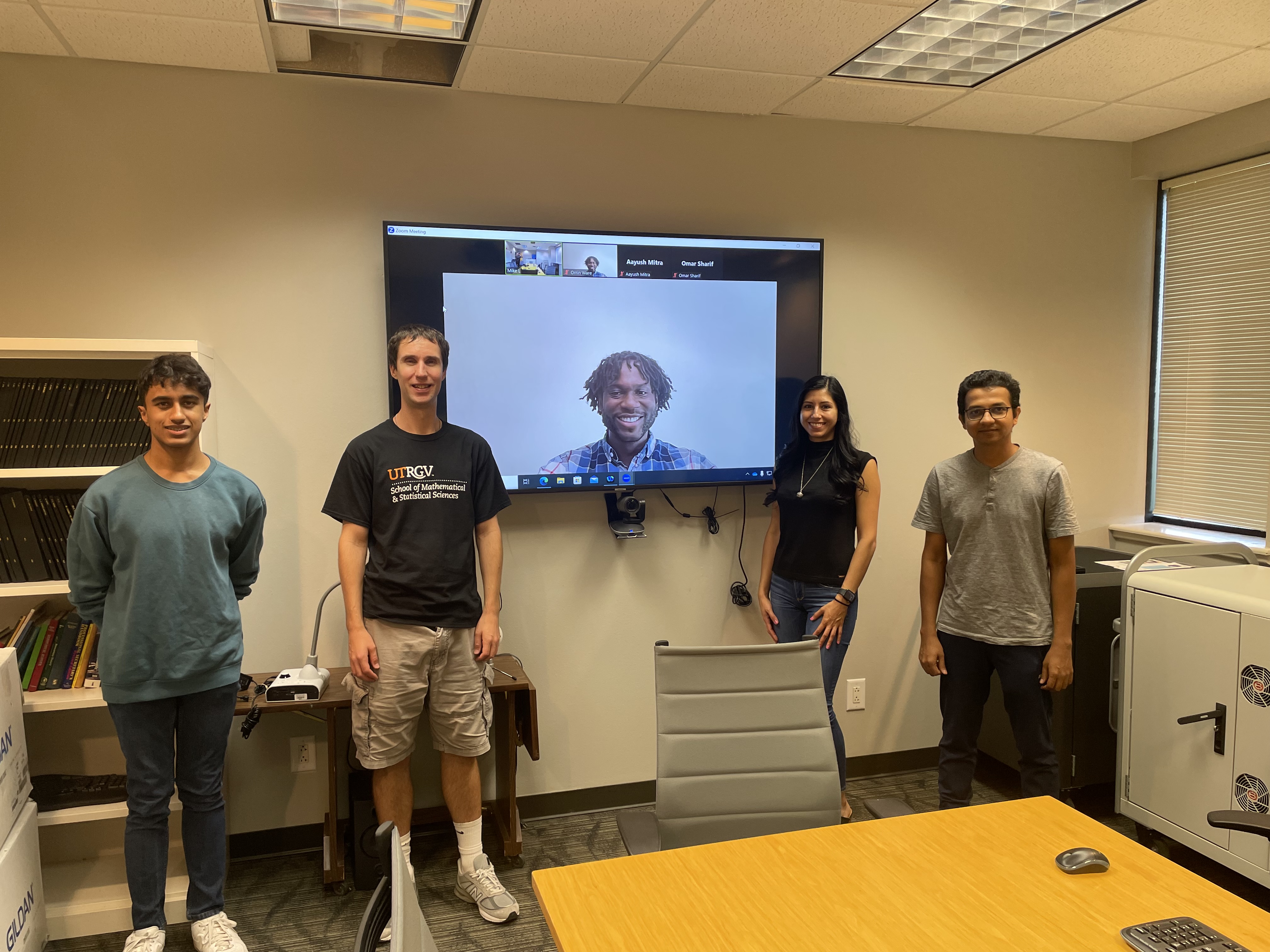
High Scholar Team: Aayush Mitra, myself, Orrin Ware, Monique Cano, and Omar Sharif. Over the 2023 summer, I mentored a team of REU students in study of the spatiotemporal model of the Unfolded Protein Response. Funds were kindly provided by Erwin Suazo through his NSF Grant. 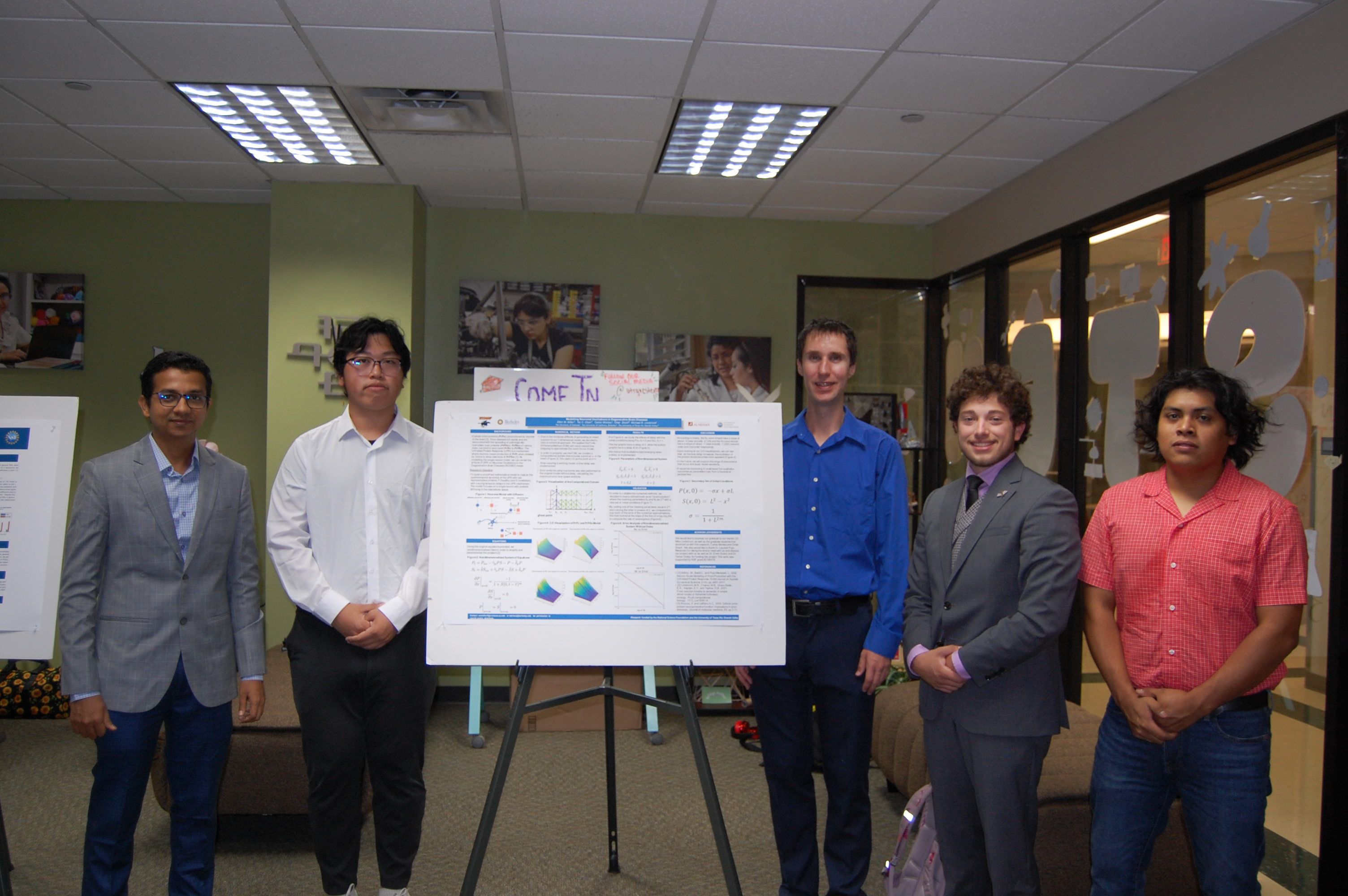
Unfolded Protein Response REU Group: Omar Sharif, Tat Chan, myself, Elliot Miller, and Carlos Montes. Over the 2022 summer, with Michael Perlmutter and Joyce Chew, we mentored students in identifying topics in interview transcripts using classical NMF followed by a transformer method. 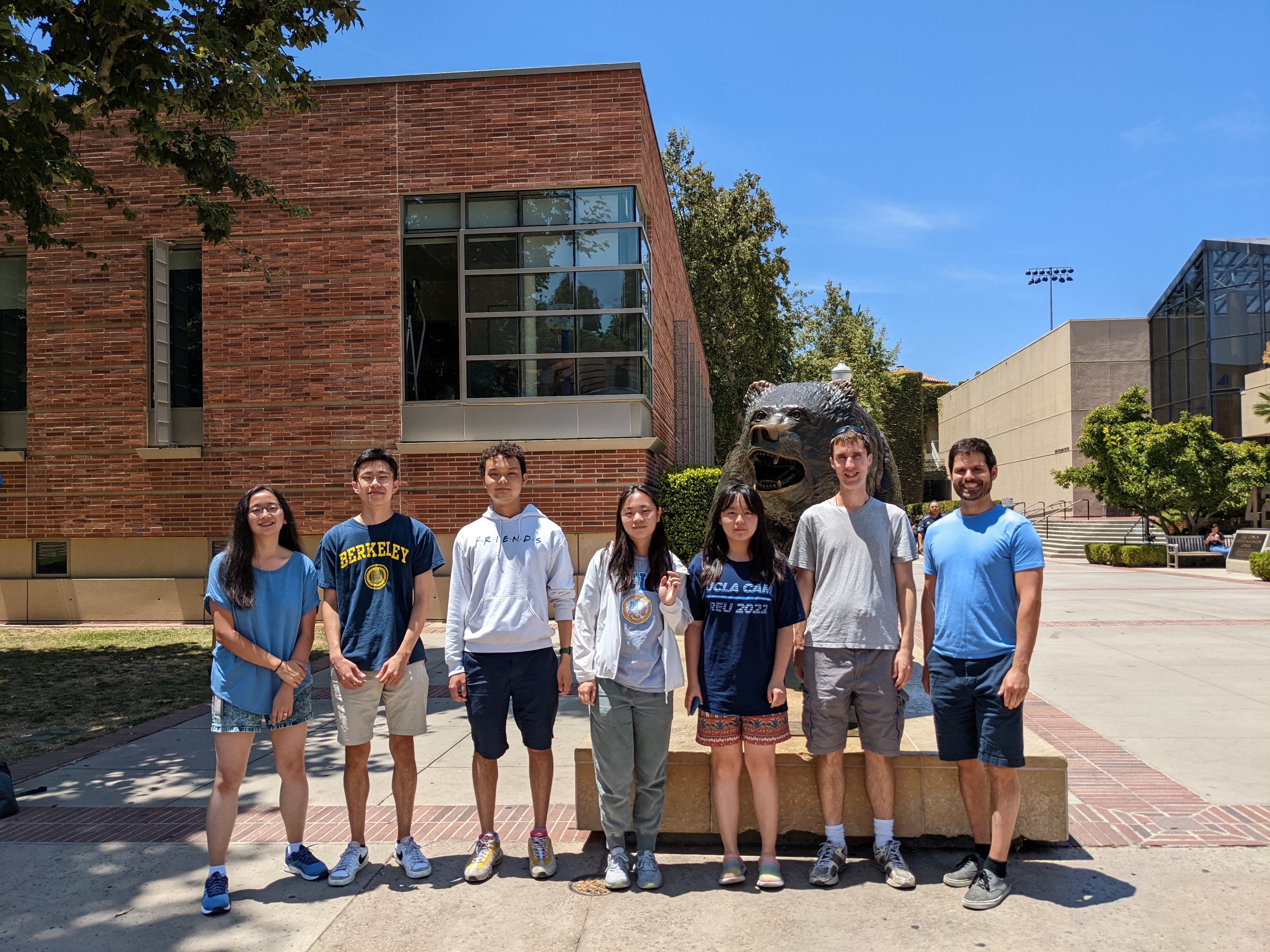
Topic Modelling REU Group: Joyce Chew, Stefan Inzer, Adrian Leung, Xiaoxian Shen, Keyi Cheng, myself, and Michael Perlmutter. -
Also over the 2022 summer, I mentored students with Sarah Burnett to study particle-laden flow of bidisperse spheres experimentally and theoretically. Team: Jack Luong, Haoyang Lyu, Jerry Soong, Hong Kiat Tan, Tang Mohan, Sarah Burnett, and myself. -
Over the Spring 2022 quarter at UCLA, I worked with two groups of student researchers. In one group, we further developed a model of the spontaneous development of prion diseases and in the other group we worked on a novel method to combine topic modelling and regression. 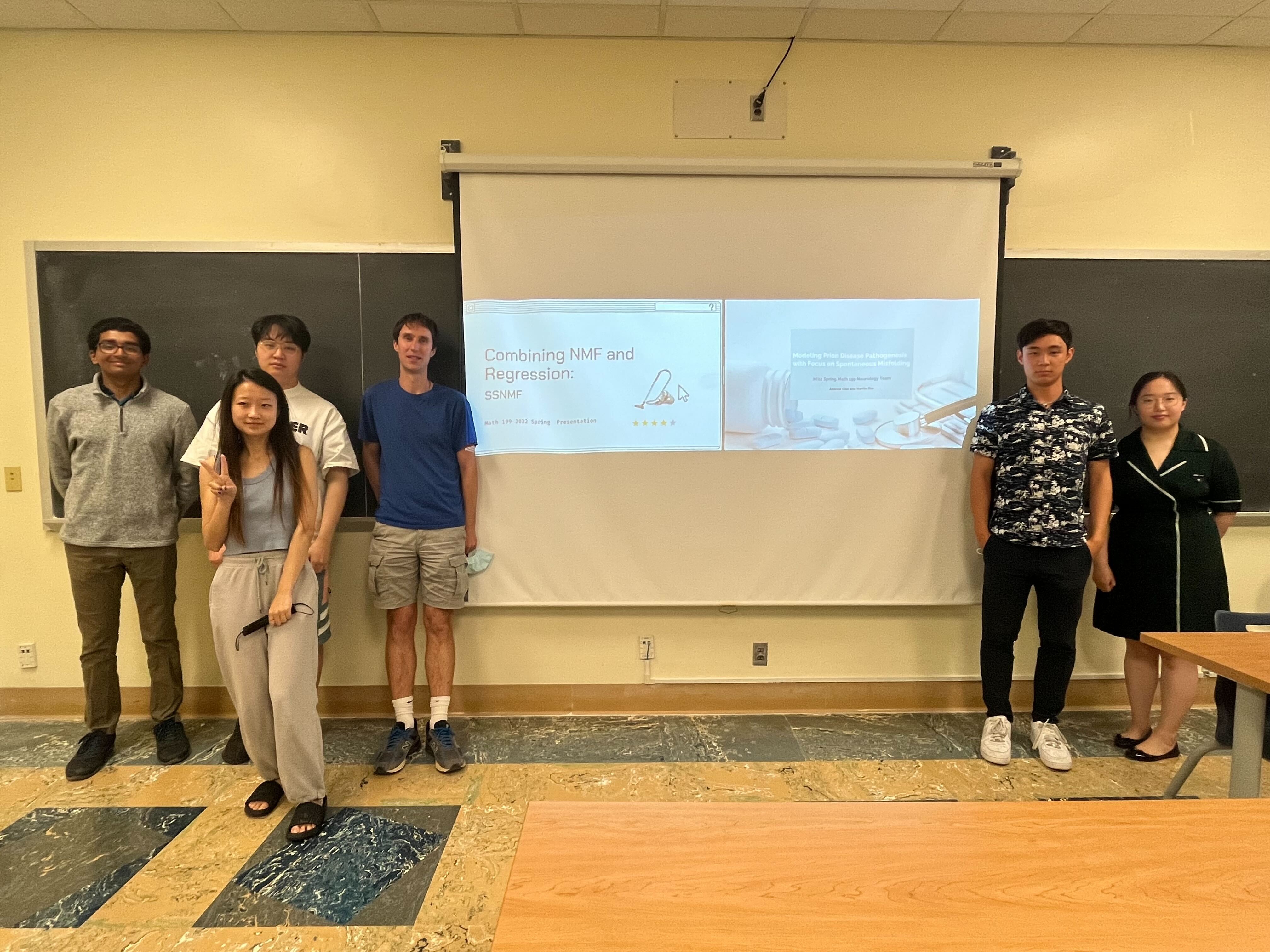
Spring 2022 Math 199 Teams: Anand Somayajula, Jenny Ding, Feng Liu, myself, Andrew Choi, and Hanlin Zhu. -
Over the Autumn 2021 quarter at UCLA, I worked with a group of students in modelling census methods for estimating the fluidity of the homeless population. We developed analytic methods and built upon previous code from this work. 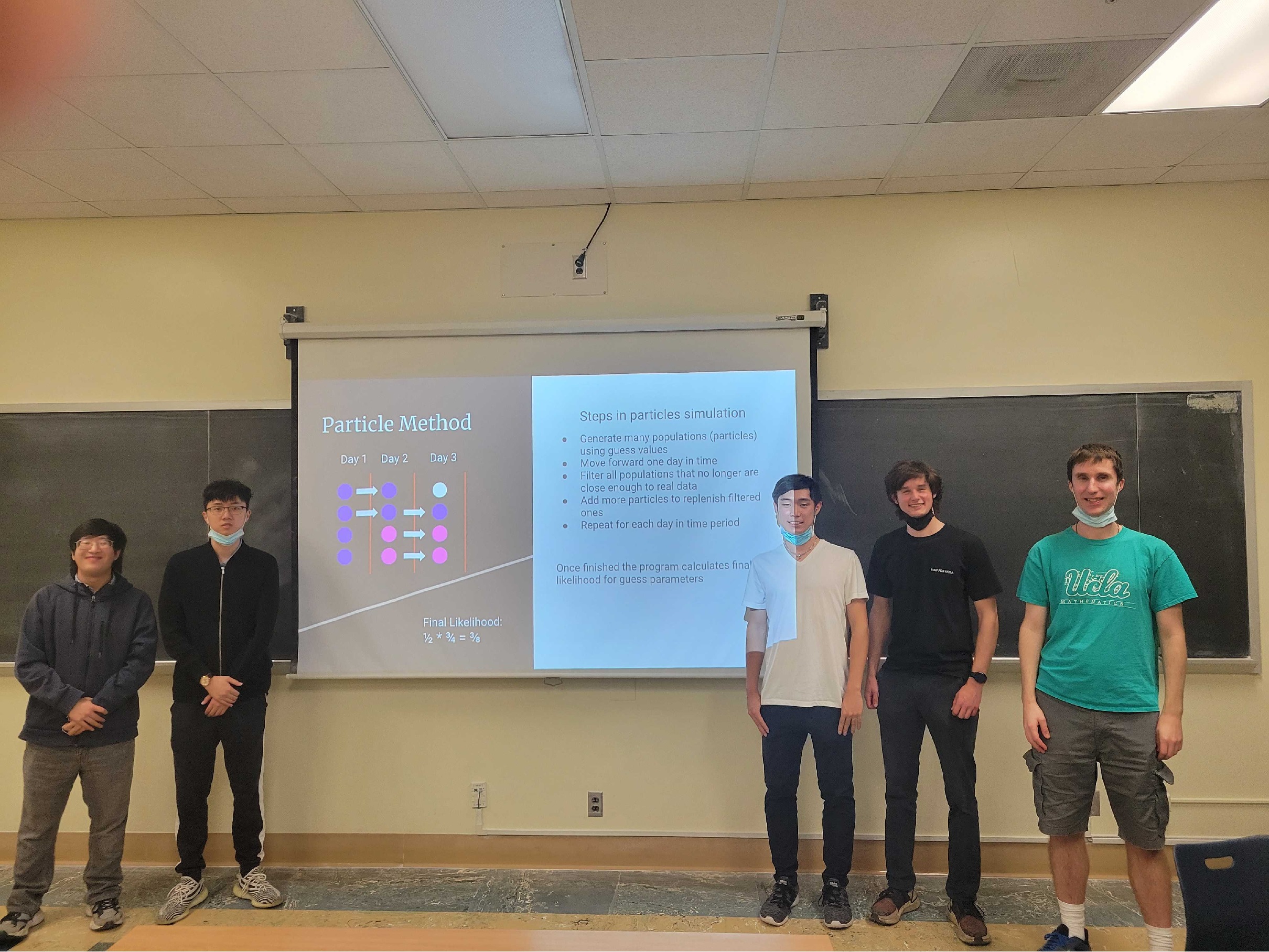
Autumn 2021 Math 199 Team: Michael Ting, Nimbus Xue, Andrew Choi, Aiden Ament, and myself. -
Over the Spring 2021 quarter at UCLA, I mentored a group of students in two separate research projects: developing a mathematical model of prion diseases and analyzing survey design strategies for estimating the fluidity of the homeless population. The neurological model was joint work with Dave Teplow from UCLA Neurology. 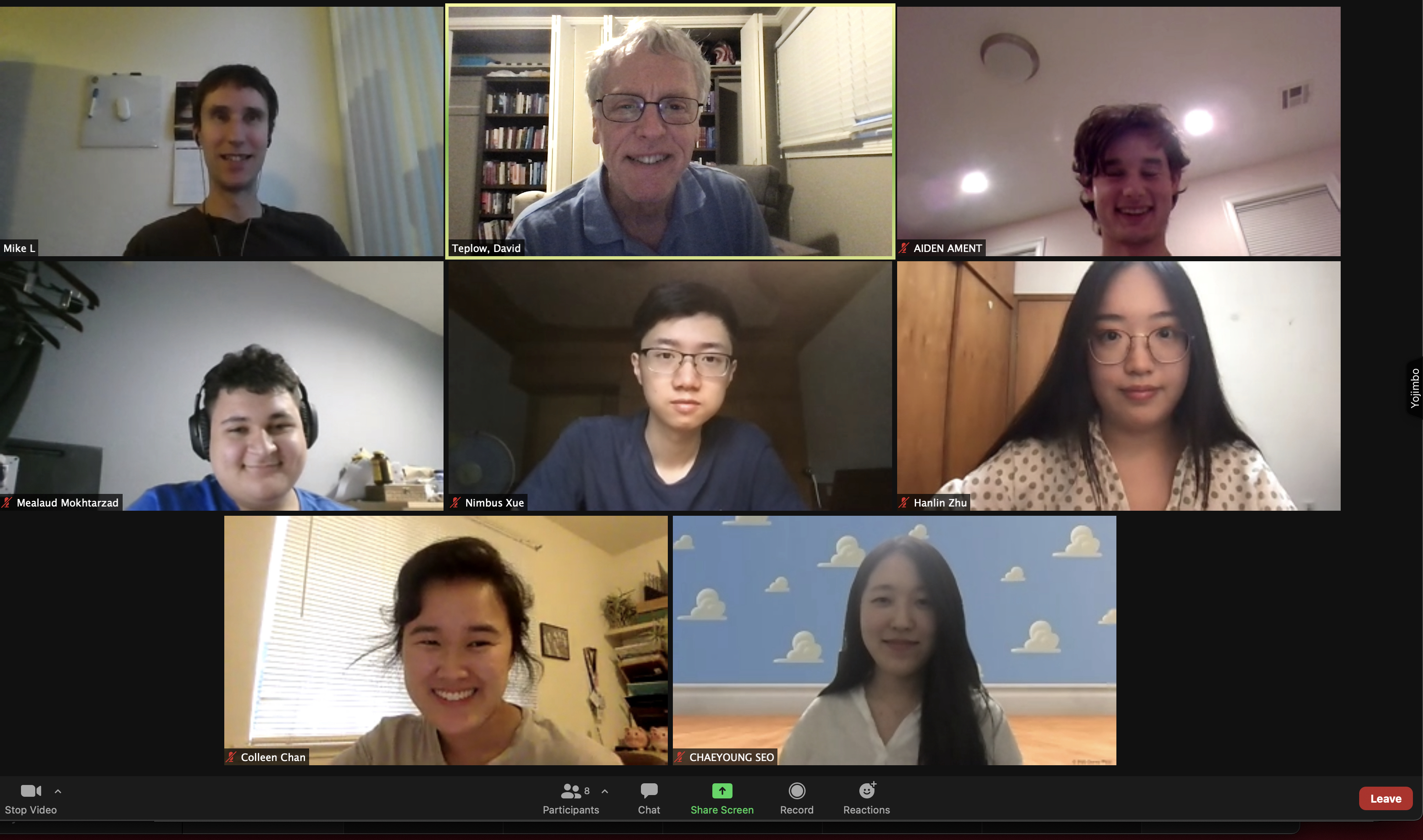
Spring 2021 Math 199 Teams: myself, David Teplow, Aiden Ament, Mel Mokhtarzad, Nimbus Xue, Hanlin Zhu, Colleen Chan, and Chaeyoung Seo. -
Over the 2020 Summer Applied Math REU, Christian Parkinson, Chuntian Wang, and I mentored a team of students investigating COVID-19 from a number of perspectives: optimal control strategies, non-compliance dynamics, and statistical models of infection. 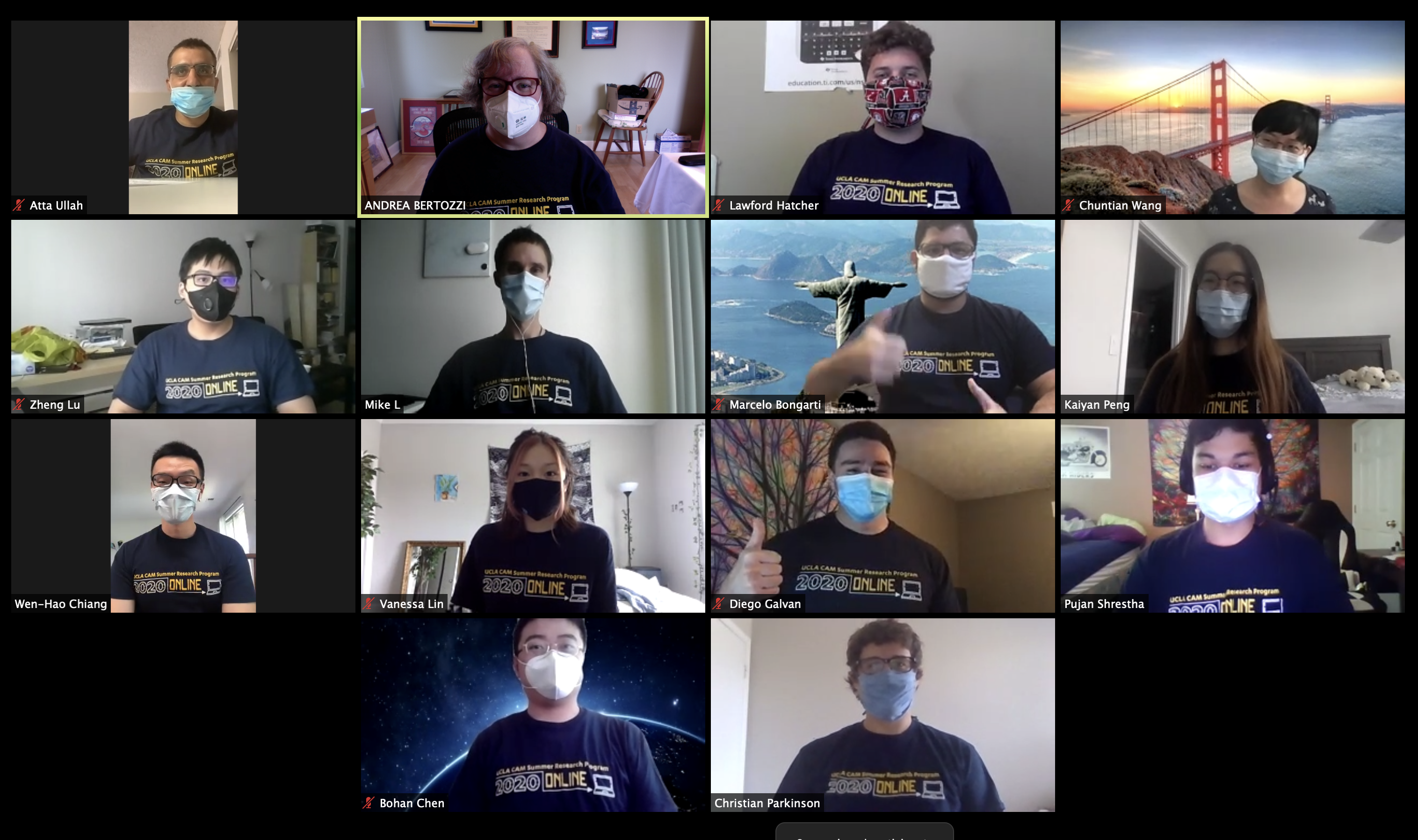
2020 COVID-19 REU Group: Attah Ulah, Andrea Bertozzi, Lawford Hatcher, Chuntian Wang, Zheng Lu, myself, Marcelo Bongarti, Kaiyan Peng, Wen-Hao Chiang, Vanessa Lin, Diego Galvan, Pujan Shrestha, Bohan Chen, and Christian Parkinson. -
Over the Spring Quarter of 2020, I ran a MATH 199 to model the effects of COVID-19 on the disabled and caregiver communities. We released a whitepaper to help guide public policy and an academic paper is under revision. The work was a collaboration not only within UCLA but from outside, as well! 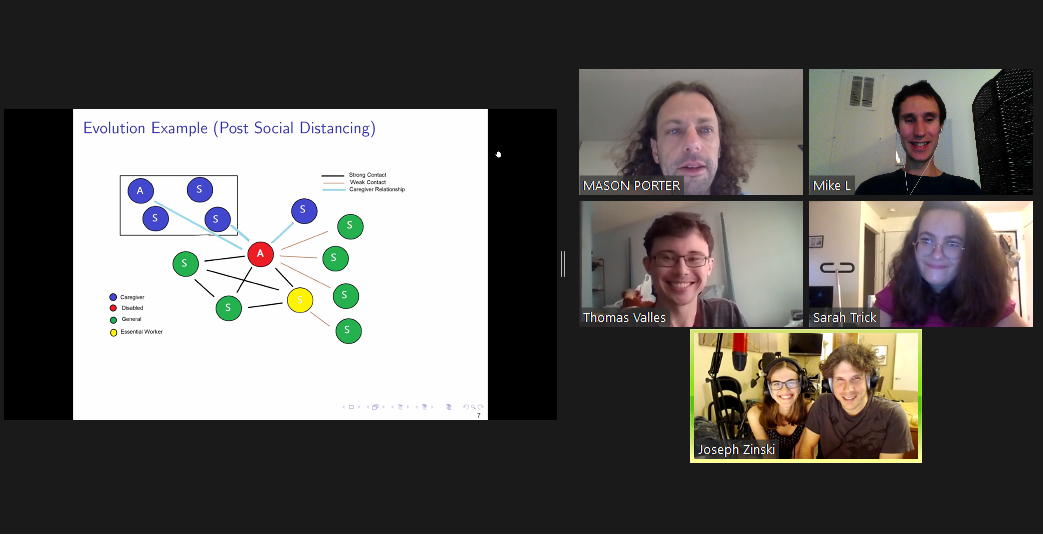
Spring 2020 Math 199 COVID-19 At-Risk Network Modelling Team: Mason Porter, myself, Thomas Valles, Sarah Trick, Hannah Shoenhard, and Joe Zinski. -
Over the summer of 2019, I mentored a group of REU students in using data science techniques to understand homicide cases in Los Angeles. 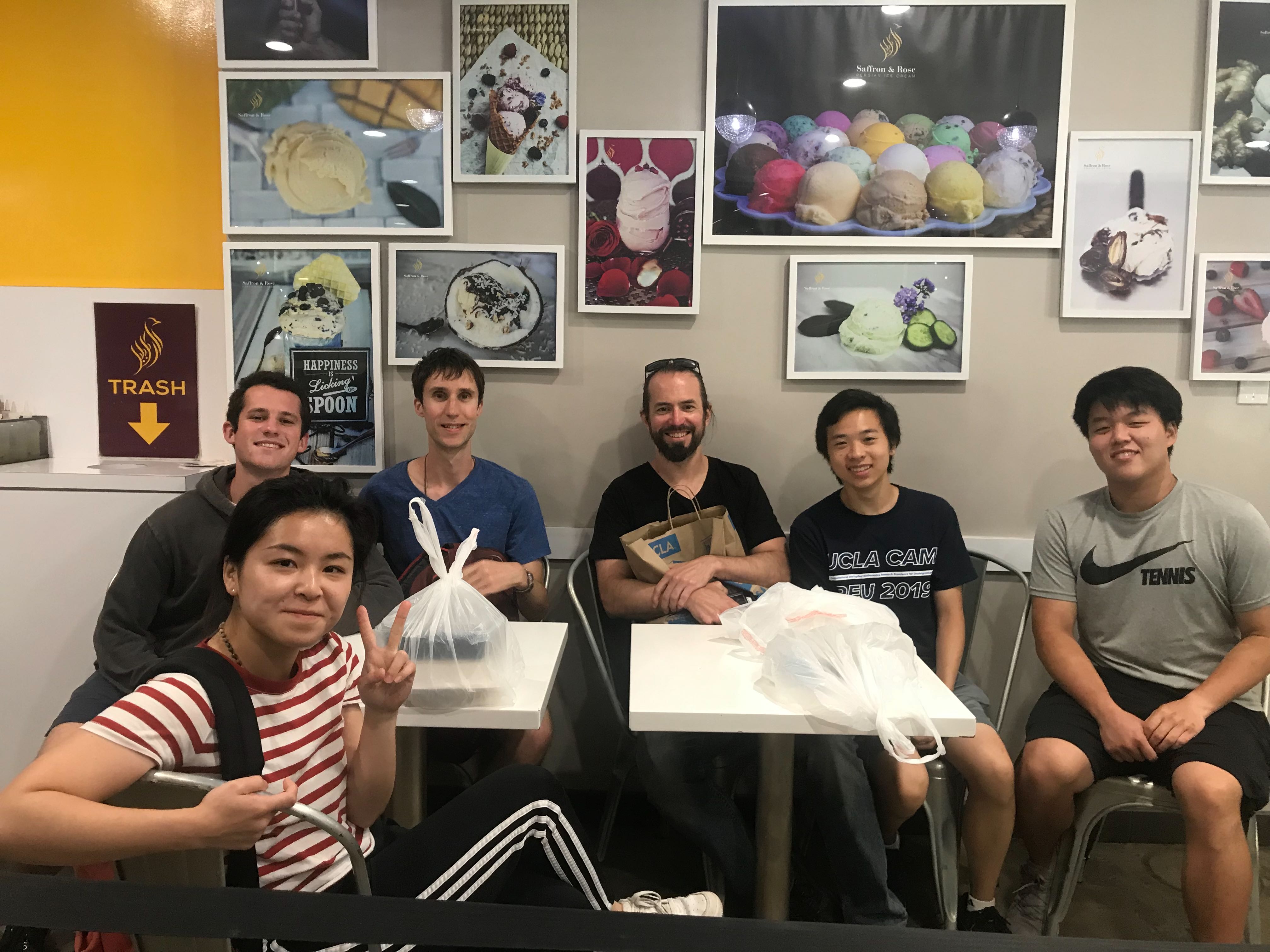
2019 Homicide REU Group: Elijah Gross-Sable, Xia Li, myself, Nate Sands, Jacky Lee, and Tyler Sam. -
Over the spring quarter of 2019, I worked with students in a MATH 199 course to model the development of Alzheimer's Disease using protein reaction kinetics and assays on cell viability. Many thanks go out to Dave Teplow from UCLA Neurology. We wrote "From reaction kinetics to dementia: a simple dimer model of Alzheimer's disease etiology" based on the work. 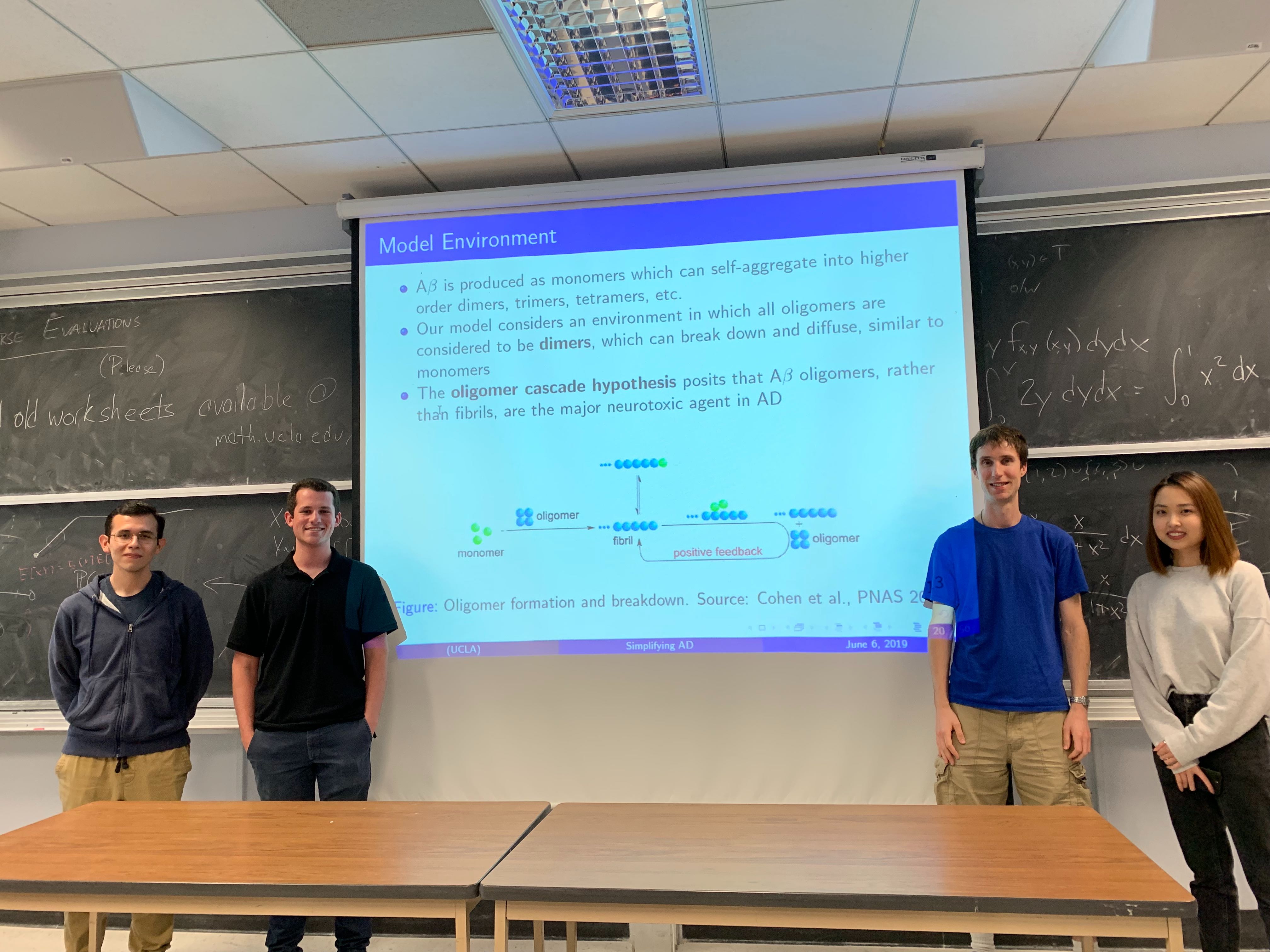
Spring 2019 Alzheimer's Math 199: Manuel Chavez, Elijah Gross-Sable, myself, and Colleen Sun. -
Over the summer of 2018, I helped Omri Azencot to mentor a group of REU students to study the effectiveness of the Gang Reduction and Youth Development program, aimed at reducing risky behaviours in youths deemed at risk for joining a gang. 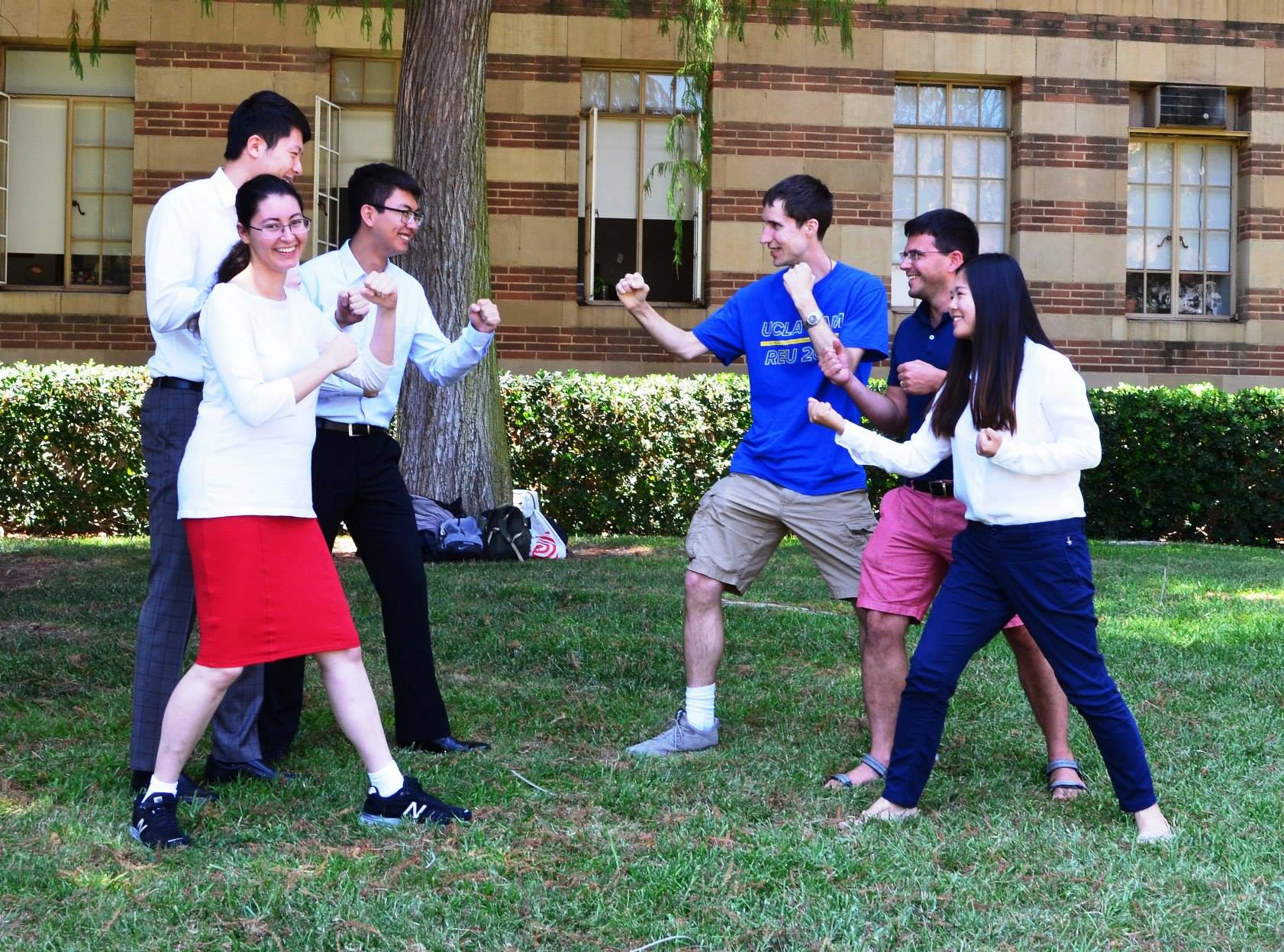
2018 GRYD REU Group: Yifan Li, Aviva Prins, Frank Mei, myself, Omri Azencot, and Qinyi Zeng. -
Over the summer of 2018, I also helped David Arnold and Christian Parkinson to mentor a group of REU students studying Los Angeles Twitter data using various techniques of data science. 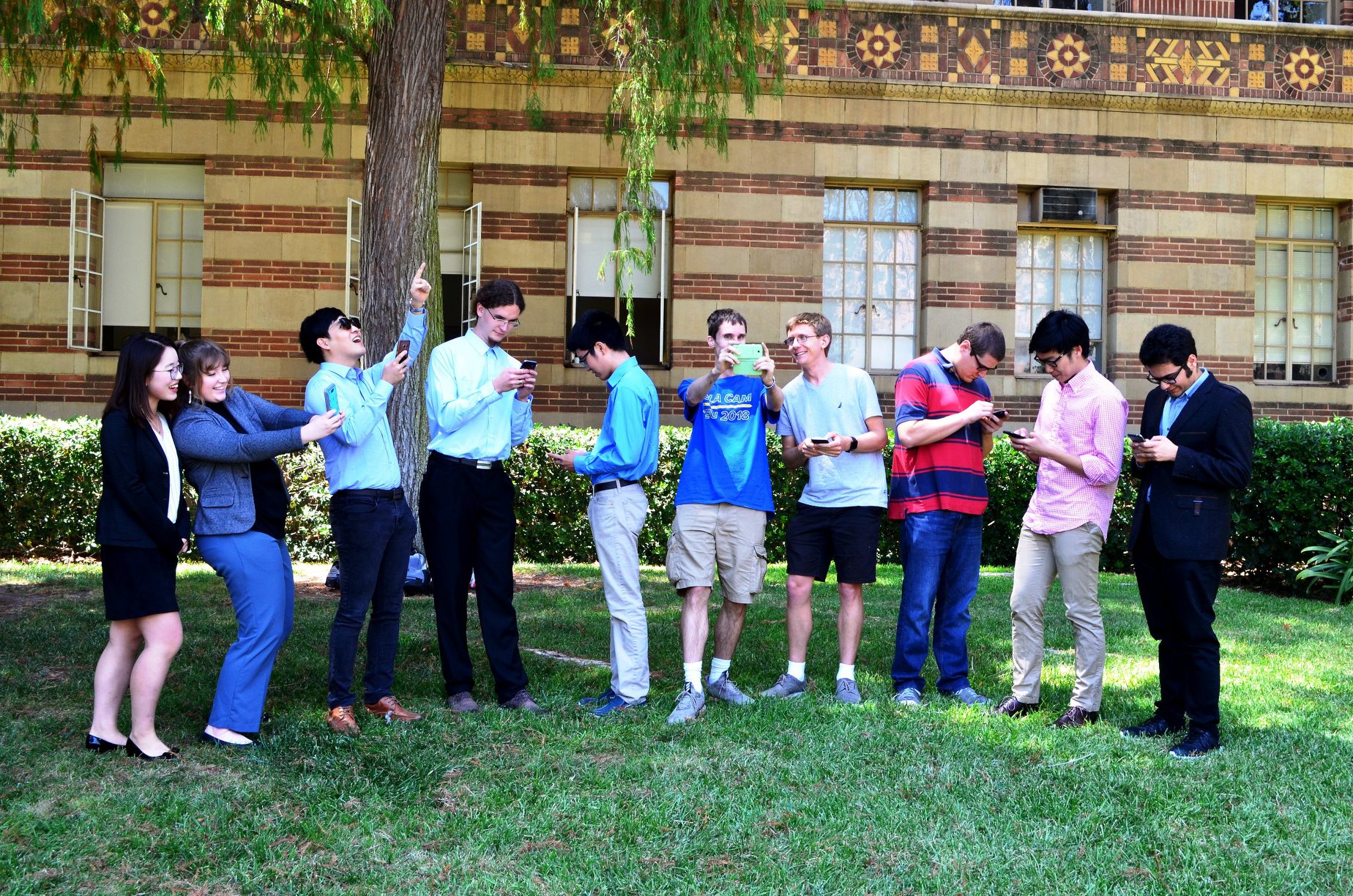
2018 Twitter REU Group: Sally Yao, Kelly Flood, Bumsu Kim, Markus Plack, Jeremy Du, myself, David Arnold, Christian Parkinson, Samuel Tan, and Matin Ghavamizadeh. -
Over the autumn 2017, winter 2018, and spring 2018 quarters, I worked with students in a MATH 199 course to use machine learning and data science tools to study factors that can predict and forecast homeless populations within Los Angeles. 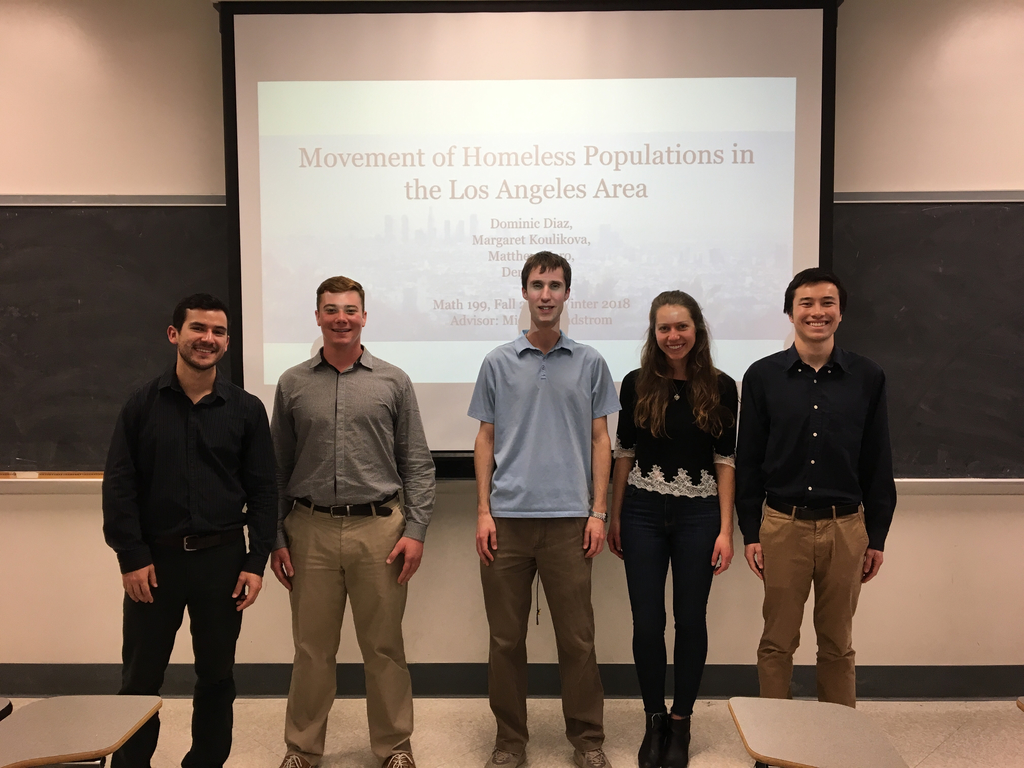
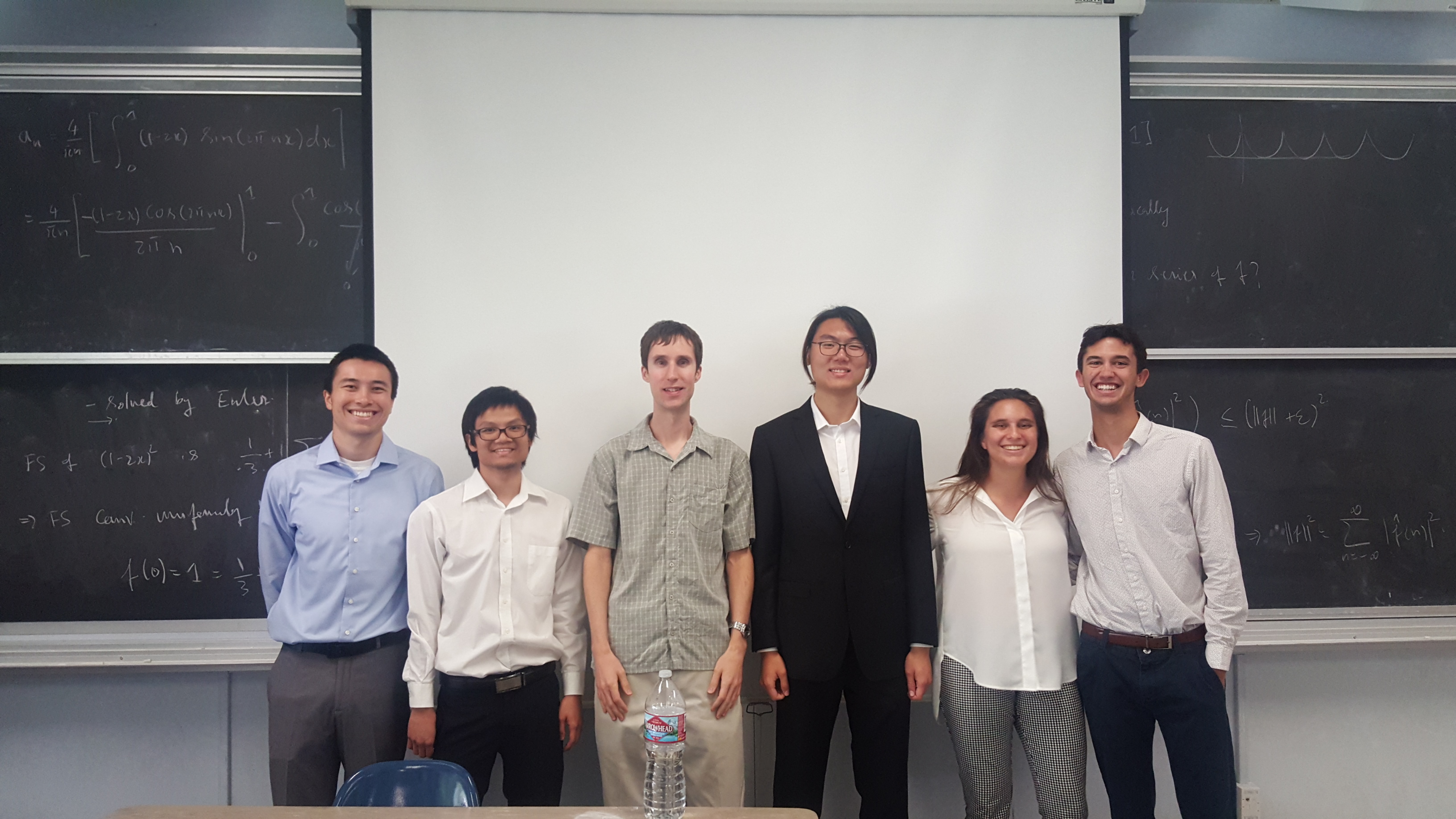
Students from autumn 2017 and winter 2018 Math 199 on homelessness (left): Dominic Diaz, Matt Nero, myself, Rita Koulikova, and Derek Yen. Students from spring 2018 Math 199 on homelessness (right): Derek Yen, Xiang Yang Ng, myself, Ryan Du, Hannah Ross, and Sanjay Shukla. -
Over the summer of 2017 through the UCLA Math Department REU program, I worked with a group of students to study homelessness. 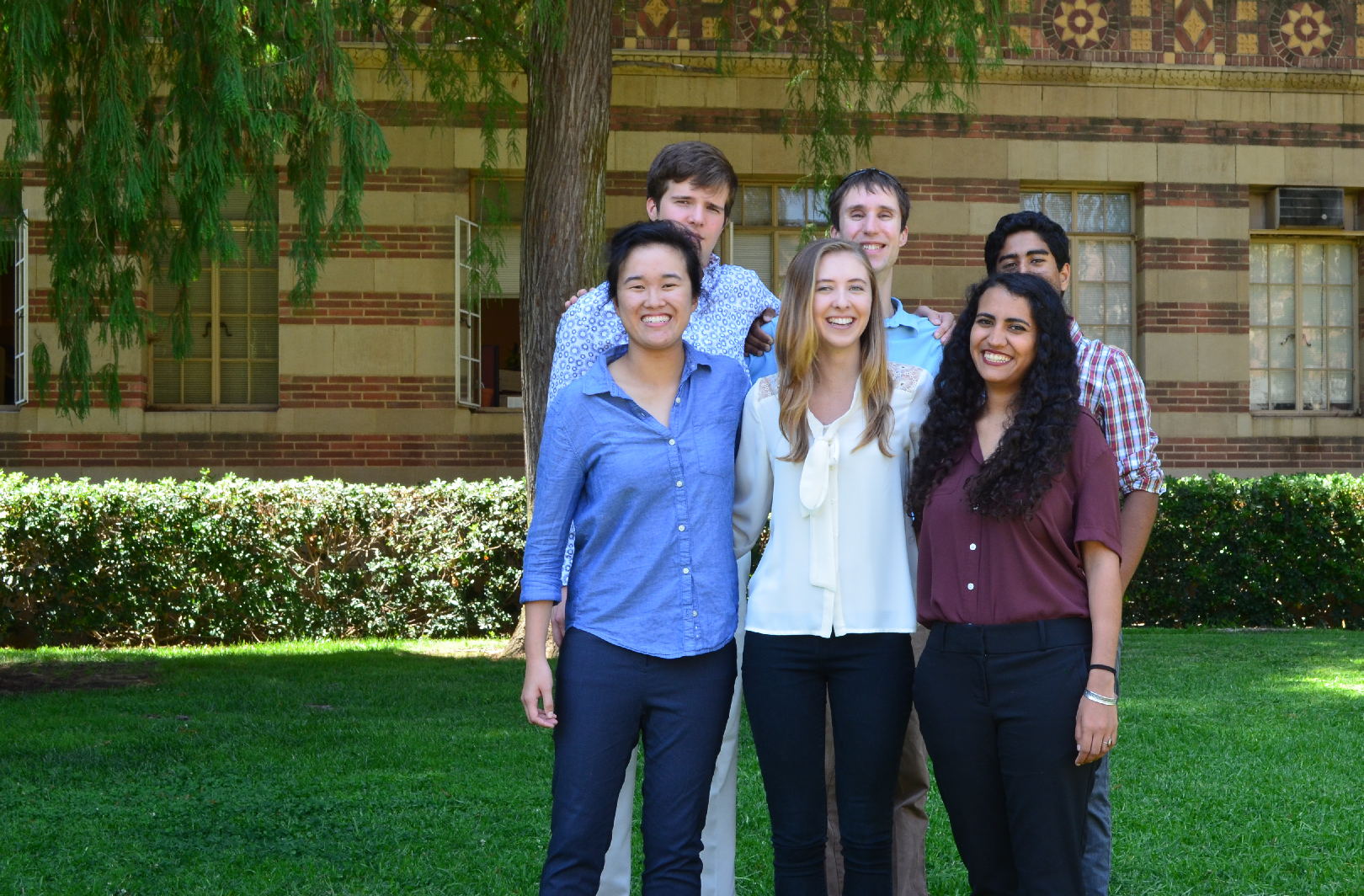
2017 Homelessness REU Group: Colleen Chan, Ethan Sargent, Emily Swanson, myself, Amina Abdu, and Arun Khanna. -
Through MATH 199 at UCLA, my colleagues David Arnold, Claudia Falcon, and I worked with a team of students to study slurry flows of bi-density mixtures. We wrote the following journal article: Investigation of Constant Volume and Constant Flux Initial Conditions on Bidensity Particle-Laden Slurries on an Incline". 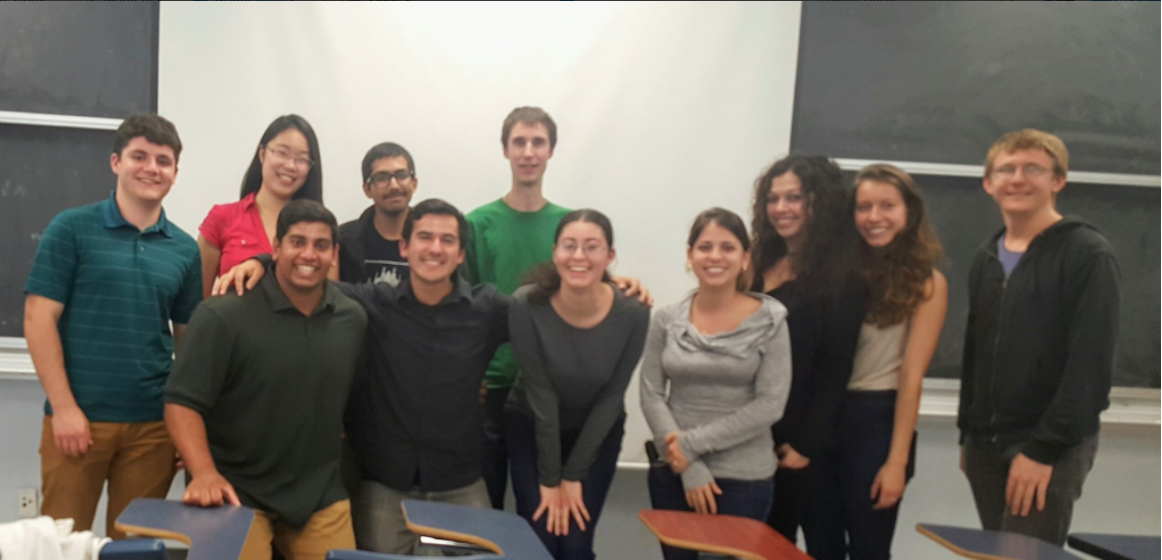
Spring 2017 Fluids Math 199: Andrew Shapiro, Clover Ye, Josh Crasto, Tameez Latib, Dominic Diaz, myself, Aviva Prins, Claudia Falcon, Jessica Boorquez, Rita Koulikova, and David Arnold. -
Over the summer of 2016, through the UCLA Math Department REU program, Jeffrey Wong and I worked with a group of students running experiments to study the physics and mathematics of slurry flow. 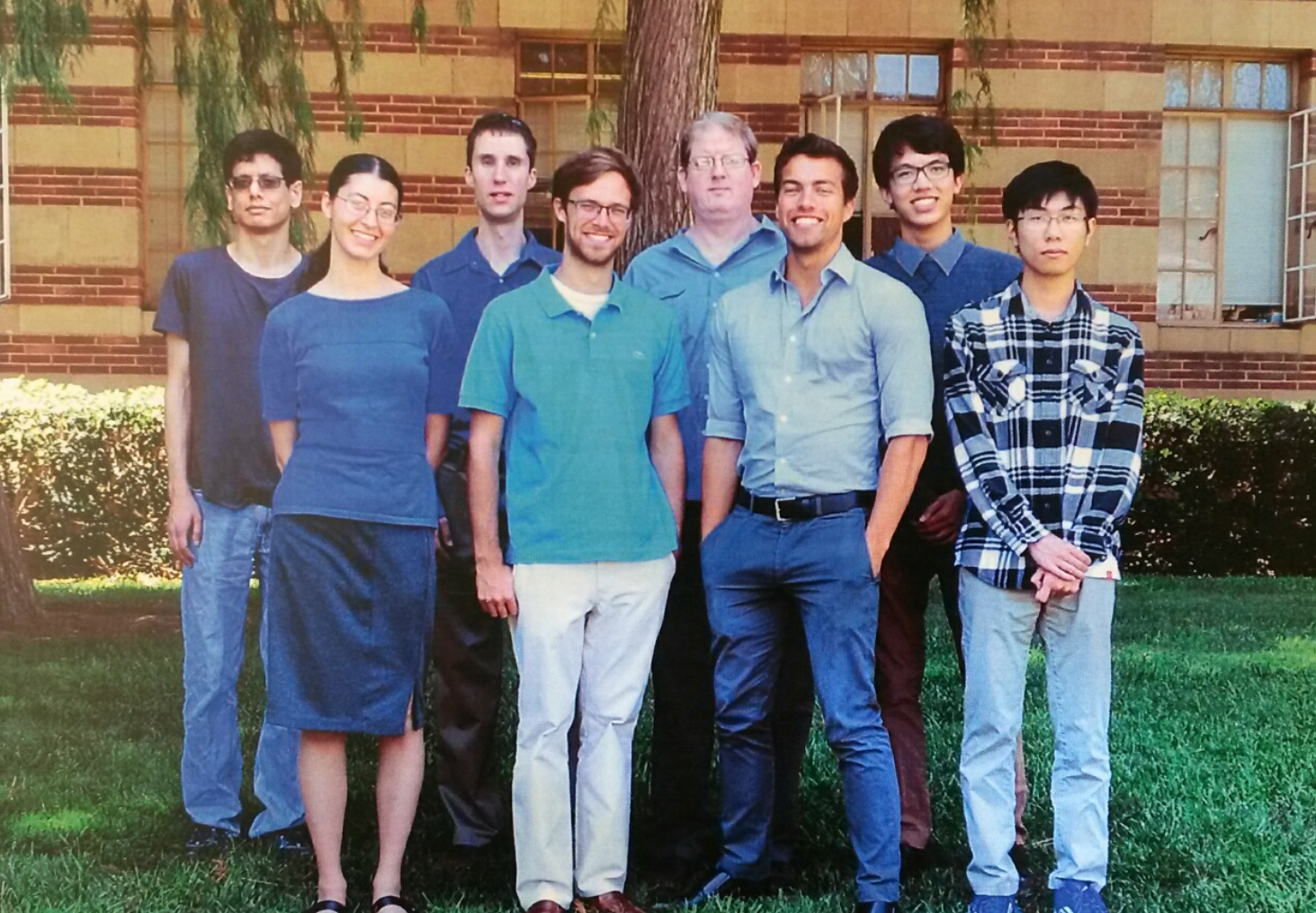
2016 Fluids REU Group: Jeffrey Wong, Aviva Prins, myself, William Sisson, Patrick Flynn, Samuel Stanton, Joseph Pappe, and Ruiyi Yang. -
Through MATH 448, a directed studies course at UBC, I worked with a former student in modelling the effects of surface roughness on superconductors. Our work was published here. 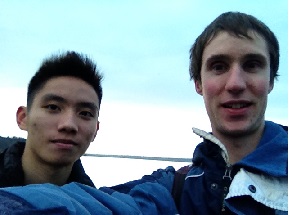
Photo with Alex.
Teaching
Teaching Positions
I am currently teaching courses at UTRGV. Prior to this, I taught at UCLA and at UBC.
The courses I teach and have taught are listed below:
Current:
-
Math 2414 (Calculus II), Spring Semester 2024, UTRGV
Past:
- Math 6340 (Computing for Math and Data Science), Autumn Semester 2023, UTRGV
- Math 2414 (Calculus II), Spring Semester 2023, UTRGV
- Math 3343 (intro to math software), Autumn Semester 2022, UTRGV
- Math 32A (differential calculus of several variables), Summer Session A 2022, UCLA
- Math 199 (prion diseases and topic modelling), Spring Quarter 2022, UCLA
- PIC 40A (intro to web programming), Spring Quarter 2022, UCLA
- PIC 10C (advanced programming, C++), Spring Quarter 2022, UCLA
- PIC 10A (intro to programming, C++), Winter Quarter 2022, UCLA
- PIC 10B (intermediate programming, C++), Winter Quarter 2022, UCLA
- MATH 199 (homeless population fluidity modelling), Autumn Quarter 2021, UCLA
- PIC 10A (intro to programming, C++), Autumn Quarter 2021, UCLA
- PIC 10C (advanced programming, C++), Autumn Quarter 2021, UCLA
- MATH 199 (prion diseases and homeless population fluidity modelling), Spring Quarter 2021, UCLA
- PIC 10C(advanced programming, C++), Spring Quarter 2021, UCLA
- PIC 40A (intro to web programming), Spring Quarter 2021, UCLA
- PIC 10B (intermediate programming, C++), Winter Quarter 2021, UCLA
- PIC 40A (intro to web programming), Winter Quarter 2021, UCLA
- MATH 199 (network modelling of COVID-19), Autumn Quarter 2020, UCLA
- PIC 10A (intro to programming, C++), Autumn Quarter 2020, UCLA
- PIC 10C (advanced programming, C++), Autumn Quarter 2020, UCLA
- Math 199 (network modelling of COVID-19), Spring Quarter, 2020, UCLA
- PIC 10B (intermediate programming, C++), Spring Quarter 2020, UCLA
- PIC 40A (programming for the internet), Spring Quarter 2020, UCLA
- PIC 10A (intro to programming, C++), Winter Quarter 2020, UCLA
- PIC 40A (programming for the internet), Winter Quarter 2020, UCLA
- PIC 10A (intro to programming, C++), Autumn Quarter 2019, UCLA
- PIC 40A (programming for the internet), Autumn Quarter 2019, UCLA
- Math 199 (modelling Alzheimer's Disease), Spring Quarter 2019, UCLA
- PIC 10B (intermediate programming, C++), Spring Quarter 2019, UCLA
- PIC 40A (programming for the internet), Winter Quarter 2019, UCLA
- PIC 10B (intermediate programming, C++), Winter Quarter 2019, UCLA
- PIC 40A (programming for the internet), Autumn Quarter 2018, UCLA
- Math 199 (modelling homeless population dynamics - continued), Spring Quarter 2018, UCLA
- PIC 10B (intermediate programming, C++), Spring Quarter 2018, UCLA
- Math 199 (modelling homeless population dynamics - continued), Winter Quarter 2018, UCLA
- PIC 10B (intermediate programming, C++), Winter Quarter 2018, UCLA
- Math 199 (modelling homeless population dynamics), Autumn Quarter 2017, UCLA
- PIC 10B (intermediate programming, C++), Autumn Quarter 2017, UCLA
- Math 142 (mathematical modelling), Summer Session C 2017, UCLA
- PIC 10A (intro to programming, C++), Spring Quarter 2017, UCLA
- Math 199 (experiments with polydisperse particle-laden flow), Spring Quarter 2017, UCLA - co-instructed with David Arnold and Claudia Falcon
- Math 142 (mathematical modelling), Winter Quarter 2017, UCLA
- PIC 10B (intermediate programming, C++), Winter Quarter 2017, UCLA
- Math 142 (mathematical modelling), Autumn Quarter 2016, UCLA
- PIC 10B (intermediate programming, C++), Autumn Quarter 2016, UCLA
- Math 142 (mathematical modelling), Summer Session C 2016, UCLA
- PIC 40A (programming for the internet), Spring Quarter 2016, UCLA
- PIC 10A (intro to programming, C++), Spring Quarter 2016, UCLA
- PIC 10A (intro to programming, C++), Winter Quarter 2016, UCLA
- PIC 10A (intro to programming, C++), Autumn Quarter 2015, UCLA
- Math 105 (integral calculus for commerce and social sciences), Term 2, Winter 2014-2015, UBC.
- Math 448 (directed studies in mathematics), Summer 2014, UBC.
- Math 215 (ordinary differential equations), Term 2, Winter 2013-2014, UBC.
- Math 104 (differential calculus for commerce and social sciences), Term 1, Winter 2012-2013, UBC.
- Math 105 (integral calculus for commerce and social sciences), Term 2, Winter 2011-2012, UBC.
- Math 103 (integral calculus for life sciences), Term 2, Winter 2010-2011, UBC.
- Math 101 (integral calculus for physical sciences), Term 2, Winter 2009-2010, UBC.
Letters of Recommendation:
I feel I should include a short word on writing letters of recommendation. Some things to keep in mind if you ask me to write a letter:
- You may be better off getting a letter from a tenured faculty member with years of established research instead of myself. Getting a letter from someone well-known has its advantages.
- I need several weeks' notice, ideally a month or two. The less time I have, the lower the quality of letter I may be able to write for you and the more likely I will need to decline.
- Currently I only write letters for a student who earned an A in a course I have taught (or A+ at UCLA), but the story is different for students I mentor in research or research-based courses. Without an A, I cannot use statements such as "top of the class", "mastered the material", etc.
- It wouldn't hurt if I knew who you were! Don't stay anonymous. Hopefully I will have spoken to you in person at least a few times in the course. I will very likely decline if I do not know you.
- I need as much information from you as possible: unofficial transcript copies, CV/resume, any/all personal statements you are including in your application, a detailed description of what you are applying for, any deadlines, etc.
- Due to FERPA guidelines, I need you to send me a letter granting full permission to disclose information from your academic records (transcript information, course grades, GPA, etc.) to the intended recipients, a list of intended recipients (this could be a description of the type of positions/programs you are applying to), and the purpose of the letters. In addition, you must provide your signature at the bottom. You can mail, fax, or email this to me, but the letter granting consent must clearly address all of these items or I will not be able to write anything for you.
REU Matlab Demo
For a few summer Applied Math REU's, I've taught a crash coursee in MATLAB. Here are some files to demo some of the basic functions/features.
Other Education Stuff
Math Education Resources wiki
I was contributor and administrator for the Math Education Resources wiki. This project began as an online database of past UBC Math Exams with hints and solutions, and has steadily expanded to a more complete online learning resource with questions by topic and interactive features. Currently we're doing an education study on the effectiveness of the wiki.
Papers, Proceedings, Theses, etc.
Journal Papers
Accepted/Published
- Lindstrom, M.R. "Local existence of solutions to a nonlinear autonomous PDE model for population dynamics with nonlocal transport and competition" (2024, Communications in Nonlinear Science and Numerical Simulation)
- Lindstrom, M.R., Ding, X., Liu, F., Somayajula, A., and Needell, D. "Continuous semi-supervised nonnegative matrix factorization" (2023, Algorithms)
- Cheng, K., Inzer, S., Leung, A., Adrian Leung, Shen, X. Perlmutter, M., Lindstrom, M.R., Chew, J., Presner, T., and Needell, D. "Multi-scale hybridized topic modeling: A pipeline for analyzing unstructured text datasets via topic modeling" (2023, SIURO)
- Bongarti, M., Galvan, L.D., Hatcher, L., Lindstrom, M.R., Parkinson, C., Wang, C., and Bertozzi, A.L. "Alternative siar models for infectious diseases and applications in the study of non-compliance" (2022, M3AS)
- Valles, T.E., Shoenhard, H., Zinski, J., Trick, S., Porter, M.A., and Lindstrom, M.R. "Networks of Necessity: Simulating Strategies for COVID-19 Mitigation among Disabled People and Their Caregivers" (2022, PLOS Computational Biology)
- Peng, K., Lu, Z., Lin, V., Lindstrom M.R., Parkinson, C., Wang, C., Bertozzi, A.L., Porter, M.A. "A Multilayer Network Model of the Coevolution of the Spread of a Disease and Competing Opinions" (2021, M3AS special issue on Mathematics Towards COVID19 and Pandemic)
- Lindstrom, M.R., Chavez, M.B., Gross-Sable, E.A., Hayden, E.Y., and Teplow, D.B. "From reaction kinetics to dementia: a simple dimer model of Alzheimer's disease etiology" (2021, PLOS Computational Biology)
- Lindstrom, M.R. Jung, H., and Larocque, D. "Functional Kernel Density Estimation: Point and Fourier Approaches to Time Series Anomaly Detection" (2020, Entropy)
- Lindstrom, M. R., and Bertozzi, A.L. "Qualitative features of a nonlinear, nonlocal, agent-based PDE model with applications to homelessness" (2020, M3AS special issue on Swarms, Crowds, and Social Systems)
- Diaz, D., Bojorquez, J., Crasto, J., Koulikova, M., Latib, T., Prins, A., Shapiro, A., Ye, C., Arnold, D., Falcon, C., Lindstrom, M. R., and Bertozzi, A.L. Investigation of Constant Volume and Constant Flux Initial Conditions on Bidensity Particle-Laden Slurries on an Incline" (2019, American Journal of Undergraduate Research)
- Wong, J., Lindstrom, M. and Bertozzi, A. "Fast equilibration dynamics of viscous particle-laden flow" (2019, Journal of Fluid Mechanics)
- Dara, S., Lindstrom, M., English, J., Bonakdarpour, A., Wetton, B., and Wilkinson, D. Conversion of Saline Water and Carbon Dioxide into Value-Added Chemicals by Electrodialysis (2017, Journal of CO2 Utilization)
- M. Lindstrom "Assessment of the Effects of Azimuthal Mode Number Perturbations upon the Implosion Processes of Fluids in Cylinders" (2017, Physica D).
- Lindstrom, M., Fang C.Y., and Kiefl, R. "Effect of Surface Roughness on the Magnetic Field Profile in the Meissner State of a Superconductor" (2016, published in Journal of Superconductivity and Novel Magnetism)
- Lindstrom, M., Moyles, I., and Ryczko, K."Electric Ion Dispersion as a New Type of Mass Spectrometer" (2015, published in Mathematics-in-Industry: Case Studies)
- M. Lindstrom"Asymptotic Analysis of a Magnetized Target Fusion Reactor" (2015, published in SIAM Journal on Applied Mathematics)
- Bruni, C., Koch, C., Konrad, B., Lindstrom, M., Moyles, I., and Thompson, W. "From Exam to Education: The Math Exam/Educational Resources wiki" (2015, published in PRIMUS)
- Lindstrom, M., Barsky, S., and Wetton, B. "Investigation into Fusion Feasibility of a Magnetized Target Fusion Reactor" (2014, published in Journal of Fusion Energy)
- Lindstrom, M. and Wetton, B. "A Comparison of Fick and Maxwell-Stefan Diffusion Formulations in PEMFC Cathode Gas Diffusion Layers" (2015, published in Heat and Mass Transfer)
- Konrad, B., Lindstrom, M., Gumpinger, A., Zhu, J., and Coombs, D. "Assessing the optimal virulence of malaria-targeting mosquito pathogens: a mathematical study of engineered Metarhizium anisopliae" (2013, published in Malaria Journal)
- Lindstrom, M., Wetton, B., and Kiefl R. "Mathematical modelling of the effect of surface roughness on magnetic field profiles in type II superconductors" (2013, published in Journal of Engineering Mathematics)
Preprints/Submissions
- Miller, E.M., Chan, T.C.D., Montes-Matamoros, C., Sharif, O., Pujo-Mejouet, L., and Lindstrom, M.R., "Oscillations in neuronal activity: a neuron-centered spatiotemporal model of the Unfolded Protein Response" (under revision)
Peer Reviewed Conference Papers:
- Nyanney, E., Chowdhury, J.I., Philips, D., and Lindstrom, M.R., "Ice in the rough: isolating neutron scattering intensities of ice" (accepted to SMC 2023)
- Lindstrom, M.R. Swartworth, W.J., and Needell D., "Reconstructing piezoelectric responses over a lattice: adaptive sampling of low dimensional time series representations based on relative isolation and gradient size" (SMC 2021)
- Lindstrom, M., Wetton, B., and Kiefl, R. "Modelling the Effects of Surface Roughness on Superconductors" (Physics Proceedings for muSR 2011)
Non Peer Reviewed Proceedings and Whitepapers:
- Almonacid, J., Bohun, S., Bowen, D., Gkelsinis, T., Ibrahim, S., Lindstrom, M.R., Liu, J., and Ongha, K. "Turbulence in the Air" (2022, proceedings from the 12th Industrial Problem Solving Workshop in Montreal)
- Gawas, P., Jung, H., Larocque, D., Lindstrom, M.R., Poirier, G., and Ahmed, S. "Predictive Risk Modelling in Aviation Incidents" (2020, proceedings from 10th Industrial Problem Solving Workshop in Montréal -- run online)
- Lindstrom, M.R., Porter M.A., Shoenhard, H., Trick, S., Valles, T., and Zinski, J.M. "Networks of Necessity: Preventing COVID-19 Among Disabled People and Their Caregivers" (2020, whitepaper)
- Boursicot, D., Comeau, M., Gagnon, P., Gauvin, C., Han, R., Ferland-Raymond, B., Lindstrom, M., Razaaly, N., Schulz, J., Shen, J., Wong, T., and Eghbalzadeh, R. "Poisson Regression for Smooth Geographic Stratification of Risk" (2019, proceedings from 9th Industrial Problem Solving Workshop in Montréal)
Theses:
- Doctoral Thesis (2015): Investigation into the Feasibility and Operation of a Magnetized Target Fusion Reactor : Insights from Mathematical Modelling
- Masters Thesis (2010): Asymptotic and Numerical Modeling of Magnetic Field Profiles in Superconductors with Rough Boundaries and Multi-Component Gas Transport in PEM Fuel Cells
- Honours Thesis (2008): Computation of Gluon Scattering Amplitudes in N=4 SYM Gauge Theory via AdS-CFT Duality
Talks, Posters, Conferences, and Workshops
Upcoming:
Past:
- 2023 - Centre de Recherce Mathematiques Industrial Problem Solving Workshop in Montreal: problem coordinator for Radio Canada
- 2023 - CAIMS Conference
- 2023 - Coastal Bend Conference
- 2022 - University of Texas Rio Grande Valley PhD/PRF/DGA/GTA Research and Advisement Seminar (online)
- 2023 - Alamo Symposium in Statistics, San Antonio, TX
- 2023 - University of Arizona Early Career Seminar (virtual)
- 2022 - University of Texas Rio Grande Valley PhD/PRF/DGA/GTA Research and Advisement Seminar, Edinburg TX
- 2022 - Centre de Recherce Mathematiques Industrial Problem Solving Workshop in Montreal: problem coordinator for IATA
- 2022 - Cal State University, Long Beach
- 2022 - University of California, Irvine (virtual)
- 2022 - The University of Texas Rio Grande Valley Computational Applied Math Talk (virtual)
- 2022 - Portland State University Applied Math Talk (in person)
- 2021 - University of Texas at San Antonio Applied Math Seminar (virtual)
- 2021 - Texas Tech University Math Colloquium (virtual)
- 2021 - Smoky Mountains Computational Sciences and Engineering Conference (virtual): poster
- 2021 - New Trends in Nonlinear Diffusion: a Bridge between PDEs, Analysis and Geometry (virtual): participant
- 2021 - Centre de Recherce Mathematiques Industrial Problem Solving Workshop (virtual): mentor
- 2021 - CAIMS 2021 Conference (virtual): talks on anomaly detection and COVID-19
- 2021 - Oakland University Applied Math Colloquium (virtual)
- 2020 - UC Riverside PDE and Applied Math Seminar (virtual)
- 2020 - Centre de Recherce Mathematiques Industrial Problem Solving Workshop: participant in IATA problem
- 2020 - Portland State University Applied Math Colloquium (virtual)
- 2020 - UC Merced Applied Math Colloquium
- 2020 - Math 290J Seminar Talks on Machine Learning (Maximum Likelihodod)
- 2019 - NSF + ATD+AMPS Workshop: poster
- 2019 - UCLA Applied Math Colloquium: talk on homelessness
- 2019 - Centre de Recherce Mathematiques Industrial Problem Solving Workshop in Montréal: participant in Desjardins problem
- 2019 - CAIMS 2019 in Whistler: talks on homeless fluidity and predicting population changes
- 2017 - UCLA Math Undergraduate Students Association Professor Talk: talk on fluids and homelessness
- 2017 - CAIMS 2017 in Halifax: talk on homelessness
- 2017 - SoCal Fluids 2017 in San Diego: talk on fluids
- 2016 - CAIMS 2016 in Edmonton: talk on fluids
- 2016 - UCLA Applied Math Colloquium: talk on nuclear fusion
- 2015 - Slides from my PhD Defense Presentation
- 2014 - Math Department Colloquium: talk on nuclear fusion thesis work
- 2014 - Undergraduate Math Colloquium: talk on applied math research
- 2014 - Fields-MPrime Industrial Problem Solving Workshop in Toronto. Here's our group presentation.
- 2014 - PIMS YRC 2014 in Vancouver: organizer.
- 2014 - IAM seminar retreat in Vancouver: oral presentation.
- 2013 - Simon Fraser University, Applied Math Colloquium in Burnaby: oral presentation on modelling nuclear fusion.
- 2013 - Centre de Recherce Mathematiques Industrial Problem Solving Workshop in Montreal.
- 2013 - IAM Seminar Retreat in Vancouver: oral presentation.
- 2012 - CAIMS 2012 Annual Meeting in Toronto, Ontario: oral presentation.
- 2012 - UBC Math Undergraduate Colloquium at UBC: oral presentation on industrial modelling for fuel cells and nuclear reactors.
- 2011 - Applied Mathematics, Modeling and Computational Science Conference in Waterloo, Ontario: oral presentation
- 2011 - ICIAM 2011 in Vancouver, BC: poster presentation
- 2011 - 12th International Conference on Muon Spin Rotation, Relaxation and Resonance in Cancun, Mexico: poster presentation
- 2011 - PIMS YRC 2011 in Vancouver, BC: oral presentation.
- 2011 - IAM Seminar Retreat 2011: oral presentation.
Curriculum Vitae
You can read my CV here (Apr 2023).
